About us
Our Founders
- Markus A. Dahlem, PhD
- Dr. med. Klaus Podoll (1958 - 2019)
Our Mission
Making migraine visible – and clinically meaningful.
Our Values
Our work is grounded in four core values:
- Patient-centered – The individual experience is our starting point
- Science-based – Research is the foundation of our actions
- Translational – Translating insights directly into healthcare
- Digitally competent – Using technology effectively for patients
Our History
1998 – First Online Presence
For the first time, the migraine aura is published online as a scientifically grounded computer simulation – making the invisible aura visible, also to others.
The first scientifically grounded simulation of the migraine aura was developed during Markus Dahlem’s PhD research in theoretical physics — notably, without personal experience of migraines. The model is based solely on the brain’s neural architecture. The animated visuals are published on the website of the Institute for Biophysics at Otto von Guericke University.
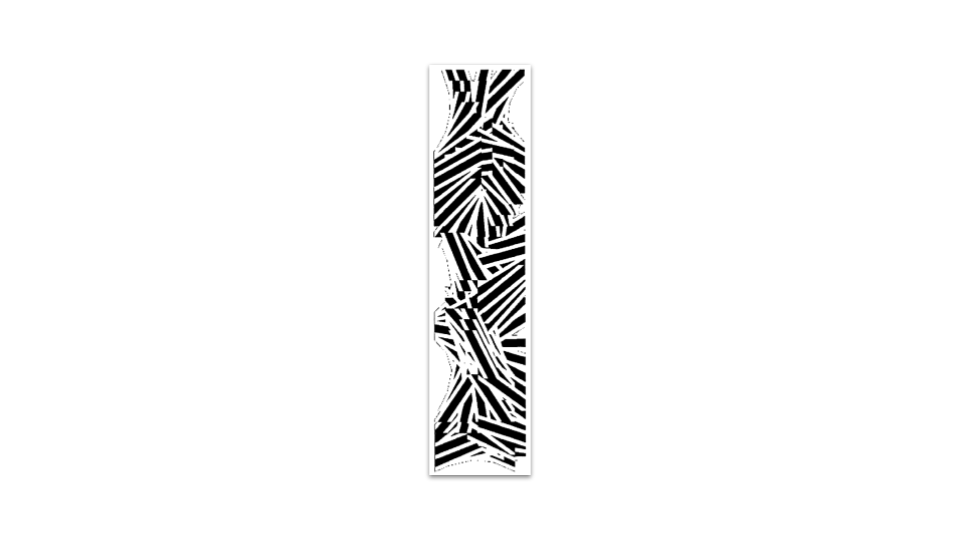
03/2000 – Encouragement from a Bestselling Author and Neurologist
A letter from neurologist and bestselling author Dr. Oliver Sacks becomes the spark for patient-centered science communication.
Following the publication of the simulation in a scientific journal, the work receives notable recognition: a personal letter from Oliver Sacks acknowledges its theoretical significance. His approach — placing the individuality of the patient at the heart of evidence-based medicine — becomes a guiding principle for shaping future science communication efforts: accessible, patient-centered, and rooted in the public understanding of science.
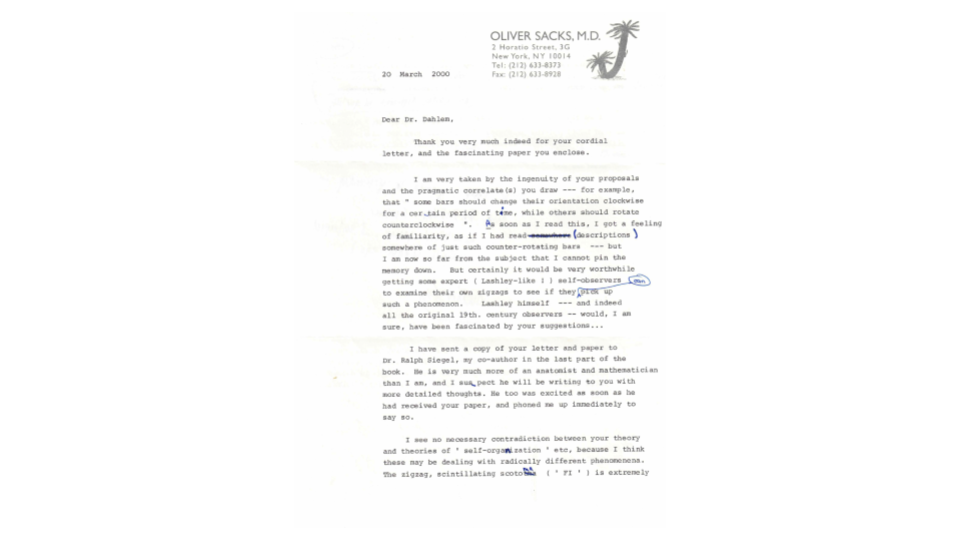
08/2000 – First Public Response
An article in DIE WELT makes the migraine aura simulation widely known and prompts numerous responses from patients.
Under the headline 'How ghost images arise in the brain', DIE WELT reports on the migraine aura simulation – and strikes a chord. Many readers with migraine respond. For the first time, they see their subjective symptoms objectively represented – visible, understandable, explainable. The simulation helps them communicate their experience – with doctors, family, and friends.

11/2000 – Patient Forum Goes Live
With a forum, guestbook, and doctor area, one of the first interactive platforms for migraine with aura is created.
Driven by public interest in the aura simulation, an interactive online platform goes live: featuring a forum, guestbook, and a protected section for doctors. In its first year, it attracts impressive traffic and initiates connections with the German Migraine League and U.S. patient organization MAGNUM. It’s an early sign of the need for structured exchange between science, healthcare, and patients.
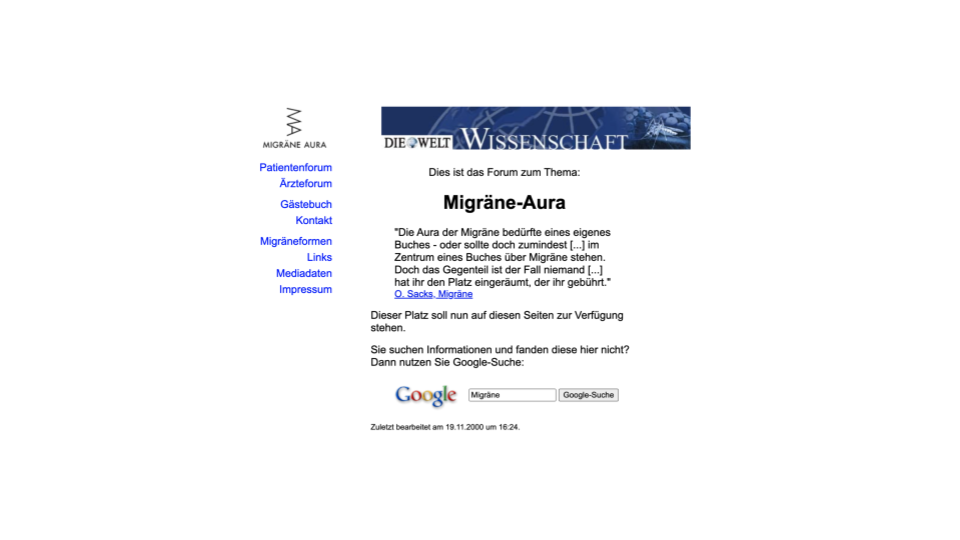
2003 – Expansion of the Migraine Art Platform
A shared vision leads to the development of one of the world’s most significant digital collections of lived aura experiences.
In 2003, the platform’s scope expands through a collaboration with neurologist Dr. Klaus Podoll, who brings an extensive archive of materials developed in earlier work with Derek Robinson, a marketing execuitive at Boehringer Ingelheim, UK. Their contributions, including Robinson’s pioneering efforts dating back to 1973 to visualize the migraine experience for educational and promotional purposes, enrich the platform’s mission. Over 1,000 emails are exchanged in the first year alone, reflecting the intensity and depth of the collaboration. What began as a dialogue about Alice in Wonderland Syndrome evolves into a curated, global repository of Migraine Art.
2004 – Foundation and Vision for Digital Medicine
Alongside the foundation, a startup idea emerges: translating migraine research into digital applications.
With a growing network, guestbook, and the Migraine Art section, the Migraine Aura Foundation is officially founded. At the same time, a complementary entrepreneurial idea is born at the Interaction Center for Entrepreneurship in Magdeburg: MoteMedi – Mobile Telemedical Diagnostics. The aim is to translate neurophysiological knowledge into digital health applications. From the beginning, the initiative follows a dual path – nonprofit education and science communication on the one hand, translational research and digital product development on the other.
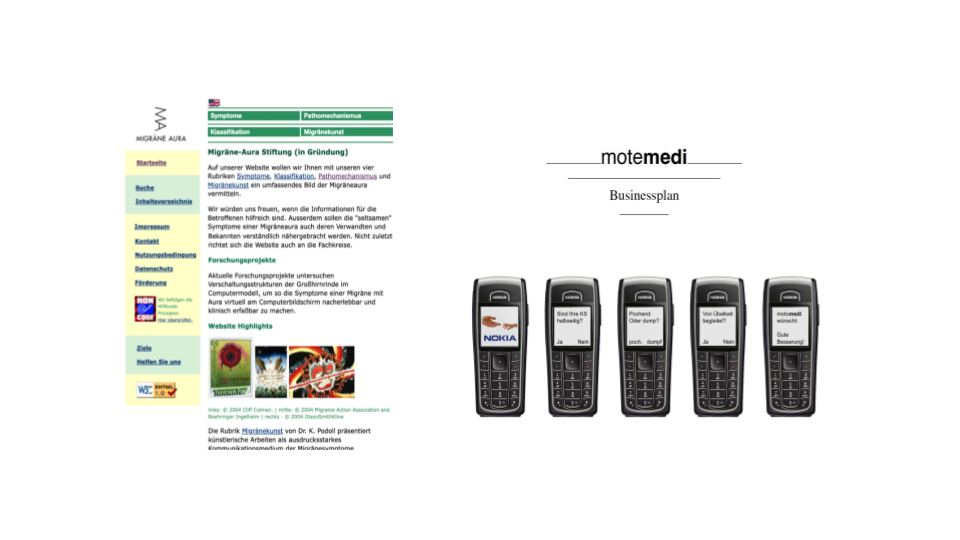
2004 – German Research Foundation Grant
A digital, personalized introspection tool is funded by the DFG – using early smartphones and exploring digital biomarkers.
With funding from the German Research Foundation (DFG), the platform begins developing an interactive tool that allows patients to engage with migraine aura simulations tailored to their individual brain anatomy. Using smartphones – still a novelty at the time, years before the iPhone – the system aimed to capture real-time brain parameters in everyday life. This early work laid the conceptual foundation for key developments in digital biomarkers and foreshadowed the vision of closed-loop, patient-responsive medicine.
2005 – Media Award
International nomination for the depiction of the migraine aura at the interface of science and art.
The website of the Migraine Aura Foundation is nominated for the International Media Award for Science and Art – a competition by SWR, ZKM, ARTE, and SF DRS honoring outstanding projects at the intersection of science and art. The submitted representation of the migraine aura ranks among the top entries and is broadcast on public television across Europe in 2005.
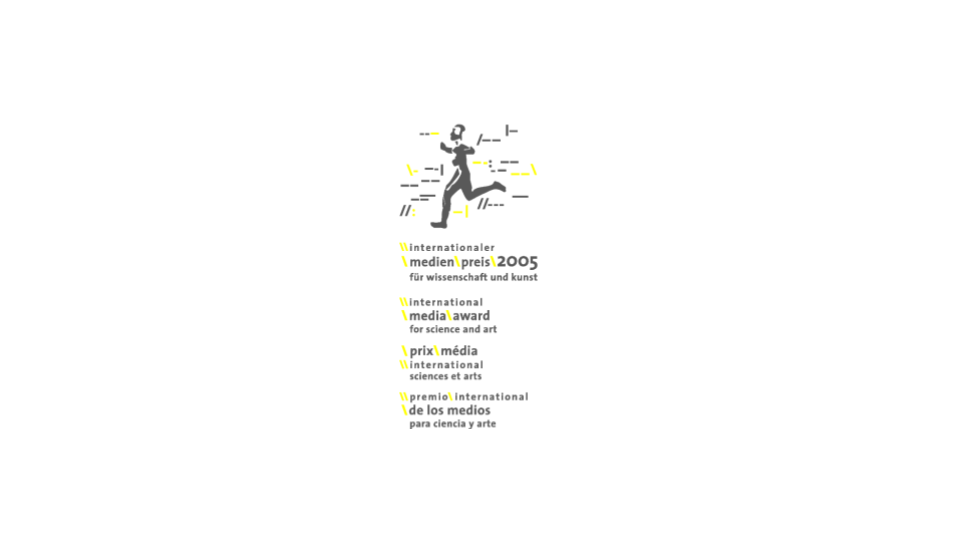
2006 – Bilingual Relaunch
A new design, improved structure – and for the first time, all content is in both German and English.
A complete website redesign introduces a modern content management system and bilingual structure. This relaunch is made possible by the media award prize money and private investments.
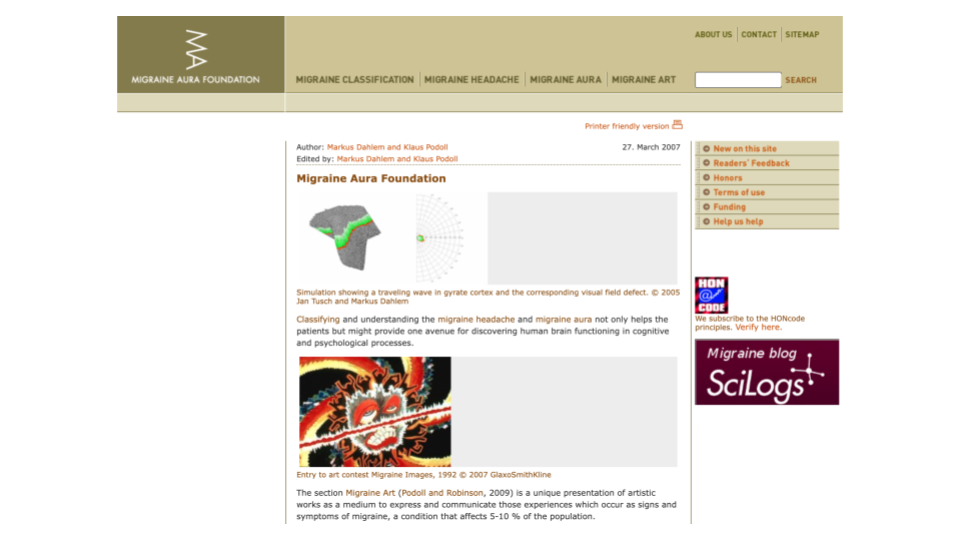
2009 – Migraine Art Becomes a Book
Thanks to the online collection, a publisher is found.
The publication of Migraine Art: The Migraine Experience from Within marks the realization of a long-standing goal. From the outset, the intention had been to publish the collection compiled by Derek Robinson and Dr. Klaus Podoll as a book – but no publisher could initially be found. The materials were therefore made publicly accessible via the foundation’s website, where they gained visibility and resonance. This digital detour ultimately led to the book’s release, documenting the rich diversity of subjective aura experiences.
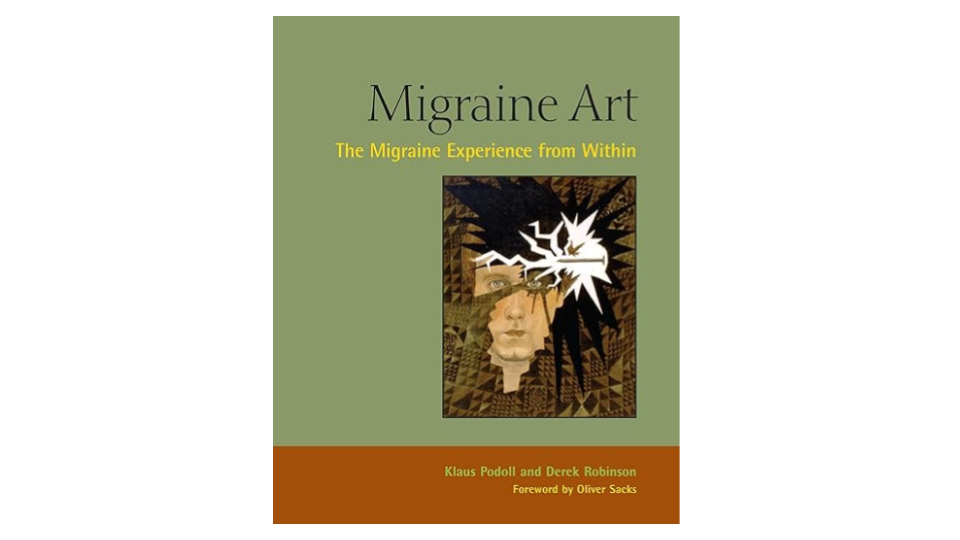
2009 – Blog on Migraine Physiology
From a website section to a science blog with over 400 posts.
In line with the foundation’s mission to spark discovery and translation, the science blog Graue Substanz launches on SciLogs, hosted by Spektrum der Wissenschaft. Over the years, it publishes more than 400 accessible posts exploring migraine physiology. Blogging activity slows after Markus Dahlem co-founds Newsenselab in 2014 — an independent company not affiliated with the foundation.
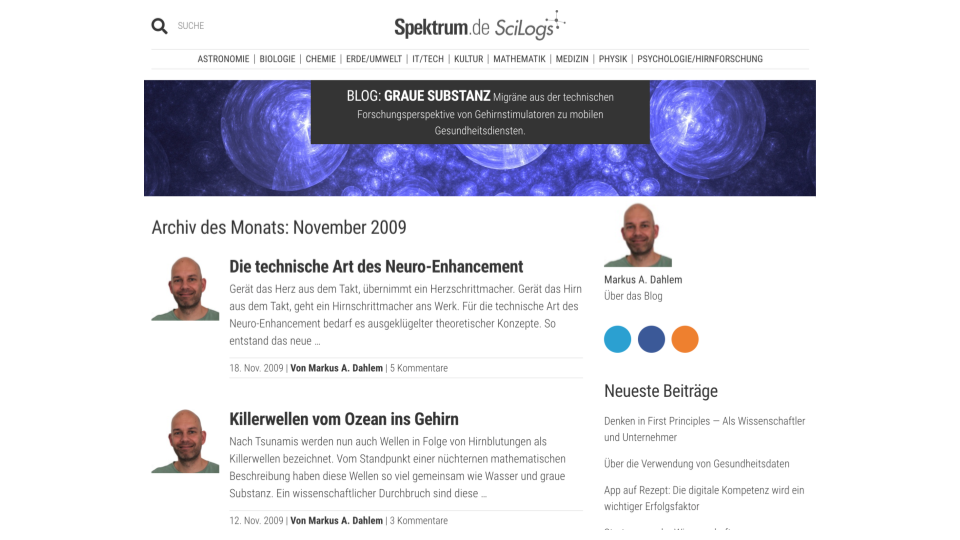
2010 – Media outreach: Migraine in a TV Special
Model-based migraine research reaches a wider audience through public broadcasting.
In January 2010, the science program nano (3sat) and Drehscheibe Deutschland (ZDF) air special segments offering a holistic view of migraine. A physics-based explanation of the migraine aura — developed in academic research by Markus Dahlem — is featured prominently. The foundation, committed to advancing public understanding of science, played a mediating role in bringing this complex, model-driven perspective into mainstream media, highlighting the value of theoretical frameworks in patient-centered communication.
2011 – Media Outreach: Literary Recognition
The foundation is featured in Siri Hustvedt’s bestseller – as a source of new perspectives on neurological experiences.
In her book The Shaking Woman, Siri Hustvedt describes how the aura experiences presented on the foundation’s website opened new perspectives for her — including historical accounts like that of Carl Linnaeus seeing his doppelgänger. Notably, the book is first published in German in 2011, underlining its resonance with a European audience.

2011 – YouTube Ban of Aura Simulation
The migraine aura simulation allegedly triggers migraine – or is it actually therapeutic?
The video, scientifically grounded and accompanied by a warning, was viewed over 40,000 times before being abruptly taken down — reportedly because it might trigger migraine. A YouTube channel is, of course, not a certified medical product. But if a digital intervention is considered capable of provoking symptoms, its therapeutic potential deserves just as much scrutiny. The takedown thus became a symbolic turning point — the conceptual starting point for what would later evolve into digital aura resonance therapy.
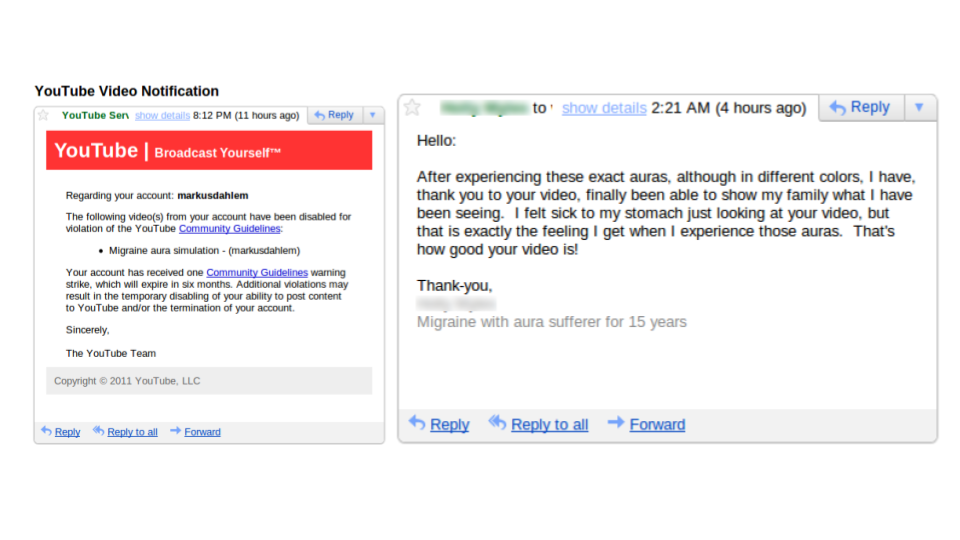
2015 – Media Outreach: Aura Resonance Therapy on the Radio
A segment on Deutschlandfunk introduces a novel, physics-based treatment concept to a broader public.
Deutschlandfunk features Markus Dahlem’s research into migraine as a physical phenomenon, highlighting the idea of interrupting the brain’s traveling aura wave using LED glasses. The broadcast signals public interest in the model-driven concept, suggesting its relevance beyond academic circles. This resonance helps lay the conceptual groundwork for the later founding of Newsenselab — an initiative, while independent of the foundation, well aligned with the foundation’s value-driven mission.
2016 – GDPR-Induced Pause
The website goes offline – and the pause leads to a new direction.
Legal uncertainties about whether the thousands of patient reports, all documented with consent, meet the new GDPR requirements lead to the precautionary shutdown of the website in 2016. Although solutions were discussed, limited resources prevented implementation – especially since efforts were already shifting toward a new development path: the concept of neuromodulatory aura resonance as a therapy attracted investor interest. With new partners, it evolved into a digital therapeutic. Ultimately, a CBT-based method was implemented as a faster solution.
2019 – Loss of a Pioneer
With the death of Dr. Klaus Podoll, the foundation loses a key companion.
The passing of Dr. Klaus Podoll again delays the planned website relaunch and leaves a significant void. As a long-time contributor, he played a crucial role in shaping the platform’s content, network, and scientific depth.
2022 – Instagram Launch
Also on social media: aura knowledge becomes accessible, visual, and bilingual.
The Migraine Aura Foundation launches its presence on Instagram – with content in both German and English. The goal is to present aura knowledge in an accessible, visual format to reach new audiences and present existing knowledge in a contemporary way.

2025 – Website Relaunch
With Aura-o-mat and the return of the blog: the platform relaunches – more modern, interactive, and integrated.
The complete relaunch of the website brings not only a new design...